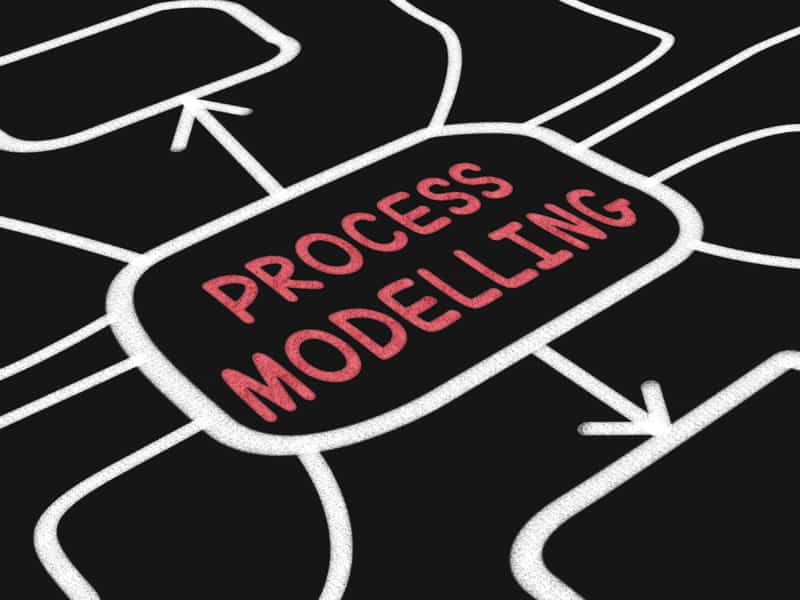This article explains why you should produce a business process model, what they are and how we can produce them.
Business process models are important for a number of reasons:
- Provides a business context for the project;
- Assists in identifying requirements;
- Establishes a shared understanding of end to end process(es) between all stakeholders across business units;
- Reflects the business process in a simple form in the ‘language’ (i.e. business processes) that the business understands;
- Is used as a ‘common thread’ throughout the project to support testing and production of training and user manuals.
Table of Contents
Business Process Model – What Is It?
So what is a business process model? The business process model shows in diagrammatic form all of the processes under consideration. It shows the trigger that initiates the process; the sequence of steps to complete the process; which business units / teams are responsible; handoffs between teams; business rules.
Business process models show several of the key elements of a business process:
- The business event that initiates the process;
- The tasks that make up the process;
- The actors that carry out the tasks or activities (these actors may, in automated or semi-automated processes;
- The sequence or flow of the tasks;
- The decisions that lead to alternative process flows;
the endpoint or outcome of the process.
A typical process model will have several levels of detail with the highest level showing, for example, the lifecycle of a customer from the point of becoming a customer through to the point their relationship ends. The detail processes will show specific interactions or transactions the customer has with the business.
It can be used to represent the current state of the business (i.e. ‘As Is’) or the target state (i.e. ‘To Be’).
There are many different forms for representing the business process but they tend to convey the same information, just with different representations. Some well known approaches include UML (Unified Modelling Language)


The process model example shown above, use activity diagrams.
Business Process Model – Why Use It?
Business process models and business process modelling are used in a variety of circumstances including business process re-engineering (BPR) and business process management (BPM) and it can play a part in process improvement approaches such as lean and six sigma. This article considers how process models can play a part in a ‘typical’ project where existing processes are impacted or new processes are introduced and does not explore lean or six sigma.
In a typical project of reasonable complexity, there is value in modelling the ‘To Be’ processes as these will be of value in the project for the reasons described at the start of the article.
There may also be value in modelling the ‘As Is’ business processes. However, this may take considerable effort so it is important this is considered and it is decided there is benefit before it is undertaken.
There is value in undertaking ‘As Is’ process modelling for the following reasons (there may be other reasons):
- Existing processes are poorly understood and will be impacted by new project;
- Business units understand only their part of the process;
- Existing processes are largely manual and project objective is to automate the existing process.
Business process models provide real value on a project as they can engage the business stakeholders in a language they understand. They also provide the bigger context for a project which when presented in a diagrammatic form can generate insights which produce a better set of requirements and identify possible requirement gaps – for example, where handoffs occur between different teams.
Business process models are used for many purposes, including:
- To document an existing process;
- To use as a basis for training members of staff;
- To understand how the process works and where the problems lie;
- To provide a basis for business process improvement;
- To identify who is involved in the entire process;
- To show the sequence of process flow activities and the alternative flow activities.
Building the Business Process Hierarchy
The business process modelling technique is often used in a hierarchical fashion. The high-level view of the business processes forms the top level of the hierarchy.
If this is a large and complex area of processing, it is sometimes useful to build an intermediate model showing the key actors, processes and sequences of work. The next step downwards, below the intermediate model if one has been produced, is to build a business process model that represents the detail of the process – its actors, tasks, decisions and flows of work.
At the bottom level of the hierarchy are the tasks – the individual boxes on the process model. These are also analysed and documented.
When building a hierarchy of process it is important that a numbering system is adopted. This system should allow traceability from the high-level area of process or activity down through the hierarchy to the tasks at the bottom level.
Documenting Tasks
There are several possible approaches to documenting tasks, some using text and some a combination of text and diagrams.
A typical approach might be to use the activity modelling notation from the UML to show the series of steps carried out, and the decisions made, during the task.
It can also be useful to consider the following areas for each task:
- The event that initiates the task;
- The actor who is responsible for the work;
- The information required to carry out the task;
- The possible outputs from the task;
- The timing and quality performance measures that the actor has to adhere to when carrying out this work.
Conclusion – Business Process Modelling
Many readers of Business Analyst Mentor will also come across the terms ‘workflow model’ or ‘workflow diagram’. Workflow models are just another use of the basic process modelling technique rather than a separate or distinctive technique.
Business process modelling is usually used interchangeably with business process mapping – and can be the same depending who you ask.
Use business process modelling in your next project or assignment to help you document an existing process; provide a basis to train members of staff; help determine problems lie and most importantly provide a basis for business process improvement.
Business Process Mapping Training Courses
Business Analyst Mentor works with leading business analysis training organisations who can provide a high level of process mapping training online courses
You can find a free business process model template and some industry standard business analysis templates in the template article



